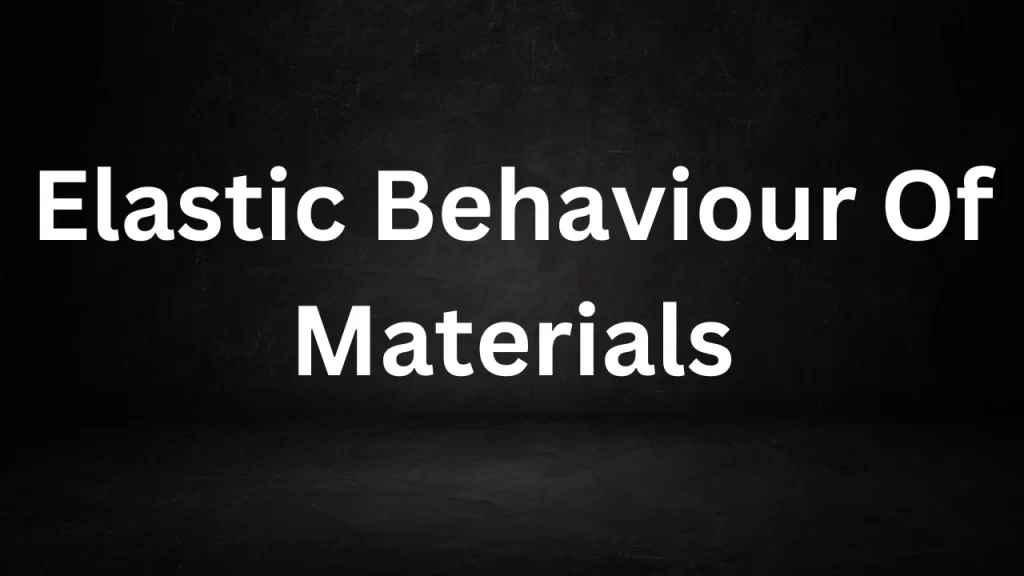Tag: electro elastic material visco elastic polymers
Elastic Behaviour Of Materials
Elastic Behaviour Of Materials: The elastic behavior of materials is a fundamental concept in the field of materials science and engineering.
It describes how materials respond to external forces and their ability to return to their original shape and size when those forces are removed.

Elastic Behaviour Of Materials
Definition of Elasticity
Elasticity refers to the property of a material to deform when subjected to an external force and then return to its original shape and size when that force is removed.
This behavior is often described as “spring-like” or “rubber-like,” as it mimics the behavior of a spring or rubber band. Elasticity is characterized by the absence of permanent deformation after the removal of the force.
Hooke’s Law
Hooke’s Law is a fundamental principle that governs the elastic behavior of materials. It states that the deformation of a material (change in its shape or size) is directly proportional to the applied force. Mathematically, Hooke’s Law is expressed as:
Where:
- is the applied force.
- is the material’s stiffness or elastic constant (also known as the spring constant).
- is the change in length or deformation of the material.
Hooke’s Law is valid within the elastic limit of a material, which is the range of stress (force per unit area) where the material behaves elastically. Beyond the elastic limit, permanent deformation occurs.
Young’s Modulus
Young’s Modulus () is a material property that quantifies its stiffness or resistance to deformation under tension or compression. It is defined as the ratio of stress () to strain () within the elastic limit:
Where:
- is the stress (force per unit area).
- is the strain (change in length per unit length).
Young’s Modulus is a measure of how a material responds to stretching or compressing forces. Materials with a high Young’s Modulus are stiff and have little elastic deformation, while those with a low Young’s Modulus are more flexible and deform more under the same force.
Poisson’s Ratio
Poisson’s Ratio () is another material property that describes how a material deforms laterally when subjected to axial (tensile or compressive) stress. It is defined as the ratio of the transverse strain () to the axial strain ():
Poisson’s Ratio is a dimensionless quantity. It provides information about how materials expand or contract in the direction perpendicular to the applied stress. Materials with different Poisson’s Ratios behave differently when subjected to stress.
Applications
Understanding the elastic behavior of materials is essential in various fields, including:
- Mechanical Engineering: Designing structures and machines that can withstand loads without permanent deformation.
- Civil Engineering: Designing buildings, bridges, and other infrastructure to ensure they remain stable under different loads and environmental conditions.
- Materials Science: Characterizing and selecting materials for specific applications based on their elastic properties.
- Geology: Studying the elastic properties of rocks to understand their behavior under geological forces.
- Biomechanics: Analyzing the elastic properties of biological tissues for medical and sports-related applications.
Conclusion
Elastic behavior is a fundamental property of materials that plays a crucial role in engineering and science. It allows materials to withstand external forces and return to their original shape and size, making it possible to design and build a wide range of structures and devices that are both functional and safe. Understanding the principles of elasticity, such as Hooke’s Law, Young’s Modulus, and Poisson’s Ratio, is essential for engineers and scientists working with materials of all kinds.
Read More
- Molecular Weight Of Oxalic Acid
- Structural Organisation In Animals
- CBSE Sample Papers for Class 11 English With Answers PDF
Frequently Asked Question (FAQs)
What is elastic behavior in materials?
Elastic behavior in materials refers to their ability to deform when subjected to an external force and then return to their original shape and size once that force is removed. It’s characterized by the absence of permanent deformation.
What is the difference between elastic and plastic deformation?
Elastic deformation is temporary and reversible, while plastic deformation is permanent. In elastic deformation, materials return to their original shape after the force is removed, whereas in plastic deformation, they retain a changed shape.
What is Hooke’s Law, and how does it relate to elastic behavior?
Hooke’s Law is a fundamental principle that describes the relationship between the applied force and the resulting deformation in elastic materials. It states that the deformation is directly proportional to the applied force within the elastic limit.
What is the elastic limit?
The elastic limit is the maximum stress or force a material can withstand without undergoing permanent deformation. Beyond this limit, the material may exhibit plastic deformation.
How is Young’s Modulus used in material science and engineering?
Young’s Modulus () is a measure of a material’s stiffness and its ability to resist deformation under tension or compression. It helps engineers and scientists select appropriate materials for specific applications and design structures that can withstand loads without excessive deformation.